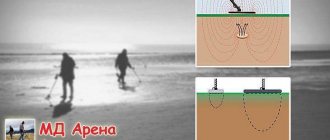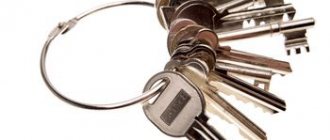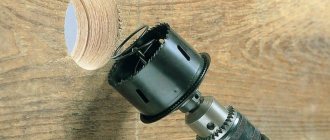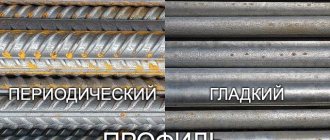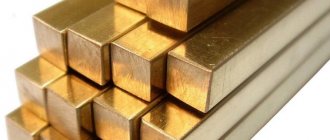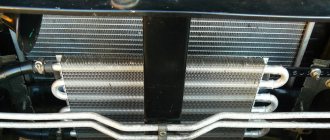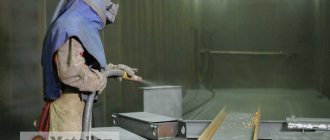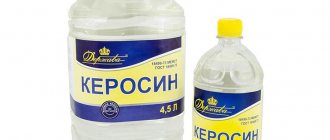Encyclopedia → Reels
Selection by manufacturer: Garrett • Minelab • Fisher • • Coiltek • Whites • Teknetics • Detech • Mars MD • Nel • Makro • Nokta • Tesoro • Golden Mask • Quest • DeepTech • Lorenz
Garrett coils (USA)
- Garrett 10x14 Mono - Ellipse, Mono
- Garrett 10x14 Power DD PROformance - ellipse, DD
- Garrett 10x14 PROformance Mono - Ellipse, Mono
- Garrett 10x14 PROformance Power DD - Ellipse, DD
- Garrett 11x14 Reaper AT DD - ellipse
- Garrett 11x14 Reaper Multi-Flex DD - Ellipse, DD
- Garrett 12.5 PROformance Imaging - round, Imaging
- Garrett 3x7 DD - ellipse, DD
- Garrett 4.5 ACE Sniper - round
- Garrett 4.5 Scorcher - round
- Garrett 4.5 Super Sniper - round
- Garrett 5x10 DD - ellipse, DD
- Garrett 5x10 Scorcher DD - ellipse, DD
- Garrett 5x8 DD PROformance - ellipse, DD
- Garrett 5x8 Ripper Multi-Flex DD - Ellipse, DD
- Garrett 6.5×9 ACE PROformance - ellipse, Concentric
- Garrett 6.5×9 PROformance - ellipse, Concentric
- Garrett 6x11 DD Viper - ellipse, DD
- Garrett 6x11 Viper Multi-Flex DD - Ellipse, DD
- Garrett 7x10 ACE PROformance - Ellipse, Concentric
- Garrett 8 Mono - Round, Mono
- Garrett 8 PROformance Mono - Round, Mono
- Garrett 8.5×11 ACE DD - ellipse, DD
- Garrett 8.5×11 PROformance DD – ellipse, DD
- Garrett 8.5×11 Raider Multi-Flex DD – ellipse, DD
- Garrett 9.5 PROformance Imaging - round, Imaging
- Garrett 9x12 ACE PROformance - Ellipse, Concentric
- Garrett 9×12 PROformance – ellipse, Concentric
- Garrett ATX 10×12 DD – ellipse, DD
- Garrett ATX 11×13 DD – ellipse, DD
- Garrett ATX 11×13 Mono – ellipse, Mono
- Garrett ATX 8 Mono - round, Mono
- Garrett ATX Deepseeker 15×20 Mono – ellipse, Mono
- Garrett TreasureHound EagleEye - depth attachment
Mono coils
Concentric, or mono, coils are designed with a maximum distance between the receiving and transmitting loops, allowing for precise target location. Mono coils are universal, they distinguish well between nearby objects made of different metals, and are used to search for all types of objects.
Compared to the DD mono coil, it has better detection depth performance, but this applies only to the central part of the sensor; the performance at the edges is much lower. A clear signal for any type of metal is another advantage of this type of coil. A mono coil is not entirely suitable for searching on highly mineralized soil; here the search depth decreases. Garrett's Concentric Imaging Coils feature an additional receiving loop for increased accuracy in identifying the type and size of a find.
| Garrett 9×12″ Mono coil for ACE | Coil 9" M Mono 7.5 kHz, Minelab X-Terra | Coil 10" Mono for F4, F2, F2 GWP |
Minelab coils (Australia)
- Minelab 10 Monoloop (Go-Find) - square, Mono
- Minelab 8 Monoloop (Go-Find) - square, Mono
- Minelab Commander 10 DD - ellipse, DD
- Minelab Commander 11 DD - round, DD
- Minelab Commander 11 Monoloop - round, Mono
- Minelab Commander 15 DD - ellipse, DD
- Minelab Commander 15 Monoloop - ellipse, Mono
- Minelab Commander 18 DD - round, DD
- Minelab Commander 18 Monoloop - round, Mono
- Minelab Commander 8 Monoloop - round, Mono
- Minelab CTX 06 Smart - round, DD
- Minelab CTX 11 Smart - round, DD
- Minelab CTX 17 Smart – ellipse, DD
- Minelab EQX 06 DD - round, DD
- Minelab EQX 11 DD - ellipse, DD
- Minelab EQX 15 DD - ellipse, DD
- Minelab FBS 11 DD – round, DD
- Minelab FBS 8 DD – round, DD
- Minelab GM 10 - ellipse, DD
- Minelab Goldsearch 10×5 DD – ellipse, DD
- Minelab Goldsearch 11 DD - round, DD
- Minelab Goldsearch 8 DD - round, DD
- Minelab GPX 11 - round, Mono
- Minelab GPX 14 - round, DD
- Minelab GPX 17 - ellipse, DD
- Minelab GPZ 14 - ellipse, Super-D
- Minelab GPZ 19 - round, Super-D
- Minelab Tornado 10 DD - round, DD
- Minelab Tornado 8 DD - round, DD
- Minelab V10 DD - ellipse, DD
- Minelab V12 DD - ellipse, DD
- Minelab V8 DD - ellipse, DD
- Minelab X-TERRA 10.5 DD – round, DD
- Minelab X-TERRA 10×5 DD – ellipse, DD
- Minelab X-TERRA 15 DD – round, DD
- Minelab X-TERRA 6 – round, Concentric
- Minelab X-TERRA 6 DD – round, DD
- Minelab X-TERRA 9 – round, Mono
Why are different coil sizes needed?
As a rule, the manufacturer installs a standard 9″-10″ search coil on its metal detectors.
This is considered medium size. With this reel you can walk across most fields. But if there is a lot of metal debris, then you have to install a coil of smaller diameter. Usually - 6″. This is required because several targets fall under the large coil at the same time: colored nails and black nails. In this case, the metal detector gives a black signal. Or incomprehensible at best. Reducing the coil diameter avoids this situation. If we have a small density of debris, then we can increase the search depth by taking a coil of a larger diameter. In addition, we will reduce the number of missed targets when searching. (see picture above)
Fisher reels (USA)
- Fisher 10 (10COIL-F5F) - Ellipse, Concentric
- Fisher 10 (10COIL-F70) - Ellipse, Concentric
- Fisher 10 (10COIL-GB2) - Ellipse, Concentric
- Fisher 10 (10COILF) - Ellipse, Concentric
- Fisher 10 Solid DD (10COILDD-GB) - Ellipse, DD
- Fisher 10.5 (10COIL-CZ3D) - Round, Concentric
- Fisher 11 DD Bi-Axial (11COIL-F4F) - Ellipse, DD
- Fisher 11 DD Bi-Axial (11COIL-F5F) - Ellipse, DD
- Fisher 11 DD Bi-Axial (11COIL-F75) - Ellipse, DD
- Fisher 11 DD Bi-Axial (11COIL-GB) - Ellipse, DD
- Fisher 11 Mono (11COIL-EE) - Ellipse, Concentric
- Fisher 14 (14COIL-7-GB) - Ellipse, Concentric
- Fisher 15 DD (15COIL-F75) - round, DD
- Fisher 4 (4COILF) - Round, Concentric
- Fisher 5 (5COIL-7-CZ3) - round, Concentric
- Fisher 5 DD (5COIL-F5F) - round, DD
- Fisher 5 DD (5COIL-F75) - round, DD
- Fisher 5 DD (5COIL-GBUG) - round, DD
- Fisher 6.5 (6COIL-E) - Ellipse, Concentric
- Fisher 6.5 (6COILE-7-GB2) - Ellipse, Concentric
- Fisher 7 Mono (7COIL-RE-F) - Round, Concentric
- Fisher 8 (8COIL-7-CZ3) - Round, Concentric
- Fisher 8 (8COIL-7BLKF) - Round, Concentric
- Fisher 8 (8COIL-7TEK) - Round, Concentric
- Fisher 9 Mono (9COIL-EE) - Ellipse, Concentric
Coil shape
Coils for metal detectors are either round or elliptical. Elliptical coils are more difficult to manufacture. But they provide some advantages when searching. Elliptical coils allow you to walk through fairly littered fields with a larger longitudinal size. Those. I provide greater search depth. These reels also have greater coverage.
Coil applicability
Coils can only work with the metal detector for which they are intended. Those. If a coil was designed to work with a specific Garrett metal detector, it will not work with a metal detector from another manufacturer (for example, Minelab). There are several reasons for this:
- discrepancy between the characteristics of mine detectors (for example, the Garrett ACE-250 metal detector operates at a frequency of 6.5 kHz, and the Fisher F75 at a frequency of 13 kHz. Of course, their coils are not interchangeable.)
- mismatch of connectors (All manufacturers install their connectors on the coil. That is, they have different diameters, with different numbers of pins, and the wiring in the connector is different)
Respectively,
- if you need coils for an AKA metal detector, then you need to look in the AKA coils section
- if you need coils for a Garrett metal detector, then you need to look in the section for Garrett
- coils for metal detectors 705, you need to look in the section for Minelab coils
But there are manufacturers of only coils (but not metal detectors). They produce sensors for various manufacturers. Here you need to carefully look at what devices these coils are intended for. Examples of such manufacturers:
- Coiltek
- Detech
Reel prices
The price for a metal detector coil ranges from $100 to $300.
On average, a reel costs $140. The coil itself is considered a consumable item and requires replacement after some time. As a rule, its service life is 3-4 years. But maybe more (depending on how carefully you treat it). But to extend its service life, protection is used on the coil, which protects it from mechanical damage (bottom and side). Making coils
for IB metal detectors presents some difficulty for those who do it for the first time.
As a rule,
factory-made
coils But making and setting up a DD coil
at home is quite simple.
This is especially true for a person who is not too rich, in the former USSR. Many IB metal detector circuits operate using a 32768 Hz quartz clock. The frequency 8192Hz divided by 4 is the main frequency for the future coil
.
Well, now let's start making coils
. First, on a sheet of paper, draw a rectangle 14.5 cm by 23 cm. After that, put 2.5 cm from the upper and lower left corners and connect them with a line. We do the same with the upper right and lower corners, but set aside 3 cm each. We put a dot in the middle of the lower part and a dot on the left and right at a distance of 1 cm. We take a suitable board, apply our sketch and drive nails (2 mm in diameter) into all points indicated earlier. Then we tear off the paper, bite off the heads of the nails and put cambrics (insulating tubes) on them. The casings protect the wire from damage at the corners and allow you to easily remove the finished coil by sliding them up. That's it, the template is ready!!! See Figure 1. Now on the template we draw the direction of winding (you can forget after the nth coil). We take multi-colored tubes 1.5 - 2 cm long (remove the insulation from a thin stranded wire). They serve two purposes: 1. You won’t confuse where the beginning is and where the end is (when the coil is ready). 2. Protects ends from breaking off. We take a 0.35mm PEV wire, thread the first tube and, securing the end to the lower studs, wind 80 turns of wire, put on a cambric of a different color and secure the end of the wire to the stud. Winding should be done in the middle of the studs (it’s easier to get everywhere). Next, without removing it from the template, we wrap the coil with a thick thread (as wire harnesses are wrapped). After this, we coat the coil with furniture varnish (straight sections, not nails). When the coil is dry, carefully moving the cambrics upward, remove the coil from the template. Squeezing the corners of the coil a little, we cover them with varnish. The next step is winding the coil with insulation (I used fum tape). Next - winding the RX coil with foil (I used a tape of electrolytic capacitors), the TX coil does not need to be wrapped with foil. Don't forget to leave a 10mm gap in the screen, in the middle of the top of the coil (shown in red in Fig. 1). Next is winding the foil with tinned wire (diameter 0.15-0.25mm). Starting from the place where the foil breaks, we wrap the coil on both sides (from the break) to the initial wire of the coil (in our case with a red tube) and twist them together there. This wire, together with the initial wire, will be our ground wire. The last step is to wrap the coil with black (fabric) electrical tape. The reason for its use is its availability and good adhesion to epoxy resin. Practice has shown that out of ten identically made coils, there was not a single one that differed greatly in inductance. The inductance of the coils is 3.680mH (mile henry) + - 0.005mH (when wound with 0.35 PEV wire). The capacitance is about 0.1 µF (100N). In the same way, but without screens, we make two more coils. Now I’ll tell you how to combine both manufactured coils into a common design and configure them. Take a sheet of getinax (3mm) measuring 30 x 27cm. See Figure 2. In 6 - 8 places we drill thin holes for attaching the RX coil. We fasten it with threads and fill the coil itself with epoxy resin. Our RX coil is located at the bottom of the sheet (closer to the ground). We position the TX coil so that the centers of the adjacent branches of the two coils are at a distance of 1 cm and secure it temporarily (you can use tape). Now we take two pieces of thin coaxial cable (about 1.5 m each) and connect the coils. I usually use thick “noodles” (LF and Video cable for VCRs) and if the coils are used in parallel, it works very well. The coil grounds (i.e., the terminals connected to the tinned wire wrapping around the coil) are connected to the screens of the coaxial cables, and the central cores of the coaxial cables are connected to the far (winding) ends of the coils. We fix 4 coins (2 kopecks of the USSR or similar) on top of the reel (using plasticine); see figure 2. Now let's move on to the setup. This setting is suitable for any MD, but will be described here in relation to circuits operating at a frequency of 8192 Hz. To do this, we use a third coil without a screen. Let’s install it on a piece of plywood, immediately solder a 0.1 uF single-core cable with a screen (coaxial) and a connector for the board (we’ll call this coil “standard”). There is no need to tune it to resonance, just set it to 0.1 uF. The “standard” coil is hung parallel to the main DD coil, at a distance of ~ 1-1.5 meters (for convenience, the cable should be 3 meters long). Now we insert the “standard” coil into the TX socket, and one of the DD coils into the RX. At the output of the first RX amplifier, we measure the amplitude (you can also use an oscilloscope), it is not its value that is important, but that it is clearly visible (slightly separated from the noise) and this is selected by the distance to the “standard” coil. We select the capacitance in the DD coil according to the maximum amplitude at the output of the first RX amplifier. Insert the next DD coil into the RX socket and repeat the settings on it. All capacitances in the DD coil are matched. Now we turn off the “standard” coil and turn on the DD coil in its place. Let's put it in Another tip: After the first stage, secure the coils tightly (with resin), leaving only the middle of the coils unfilled (with them, select 0 precisely). Thus, you can tune the coils to other frequencies, but you will have to do all the calculations yourself.
Best regards, Mikhail (MikeS).
XP reels (France)
- XP 11 DD Deus - round, DD
- XP 22.5 DD - round, DD
- XP 22.5 FMF - round, DD
- XP 22.5 HF Ellipse - ellipse, DD
- XP 22.5 HF Round - round, DD
- XP 22.5 x35 - round, DD
- XP 24x11 - ellipse
- XP 25×21 – ellipse, Concentric
- XP 27 DD High Energy - round, DD
- XP 28 FMF - round, DD
- XP 28 x35 - round, DD
- XP 30x36 - ellipse
- XP 34 FMF - ellipse, DD
- XP 34 x35 - ellipse, DD
- XP 34×28 DD - ellipse, DD
- XP 38x45 - ellipse
- XP Hoard Hunter - depth attachment
Whites reels (USA)
- Whites 10 DD - round, DD
- Whites 10 DD Sport - round, DD
- Whites 10 DD Treasure - round, DD
- Whites 12 Dual Field - Round, Concentric
- Whites 12 Super - round, Concentric
- Whites 15 Blue Max (Maxima 1500) – Round, Mono
- Whites 15 MXT Max - Round, Mono
- Whites 4×6 DD Blue Max Shooter – ellipse, DD
- Whites 4x6 DD Eclipse Shooter - ellipse, DD
- Whites 4×6 DD Goldmaster Shooter – ellipse, DD
- Whites 4x6 DD Prizm Mini - ellipse, DD
- Whites 5.3 Bullseye (6x6) - Round, Mono
- Whites 5.3 Eclipse (6x6) - Round, Mono
- Whites 6 Micro Tireur - Round, Concentric
- Whites 6 MX Six Shooter - round, Concentric
- Whites 6x10 DD Eclipse - ellipse, DD
- Whites 6x10 DD Goldmaster - ellipse, DD
- Whites 6x10 Sport - Ellipse, Mono
- Whites 7.5 Aussie - Round, Mono
- Whites 7.5 Dual Field - Round, Concentric
- Whites 8×14 DD Goldmax – ellipse, DD
- Whites 9 Spider - round, Concentric
- Whites 9 Spider Eclipse - Round, Mono
- Whites 9.5 Sport - Round, Concentric
- Whites Blue Max 950 Loop – Round, Concentric
- Whites Eclipse 950 – round, Concentric
- Whites Prizm 950 – round, Concentric
Coiltek reels (Australia)
- Coiltek 10x5 Gold Extreme - Ellipse, Mono
- Coiltek 10×5 Goldhunting – ellipse, Mono
- Coiltek 10×5 NOX - ellipse, DD
- Coiltek 10×5 Treasureseeker - ellipse, DD
- Coiltek 11 Gold Extreme - Round, Mono
- Coiltek 11 Goldhunting - round
- Coiltek 12x8 Goldhunting - Ellipse, DD/Mono
- Coiltek 12x8 Treasureseeker - ellipse, DD
- Coiltek 14 DD Pro Elite - round, DD
- Coiltek 14 Goldhunting - round
- Coiltek 14 Goldstalker - Round, Mono
- Coiltek 14 Mono Elite - Round, Mono
- Coiltek 14×9 DD - ellipse, DD
- Coiltek 14×9 Elite – Ellipse, Mono
- Coiltek 14x9 Gold Extreme - Ellipse, Mono
- Coiltek 14×9 Goldstalker Blitz – ellipse, Mono
- Coiltek 14×9 NOX - ellipse, DD
- Coiltek 15 DD - round, DD
- Coiltek 15 DD All Terrain Treasureseeker - round, DD
- Coiltek 15 DD All Terrain X-Terra - round, DD
- Coiltek 15 NOX - round, DD
- Coiltek 16 Goldstalker - Round, Mono
- Coiltek 17×11 Elite – Ellipse, Mono
- Coiltek 17×11 Goldhunting – ellipse, DD/Mono
- Coiltek 18 Elite - Round, Mono
- Coiltek 18 Goldstalker - Round, Mono
- Coiltek 18×12 Goldstalker – ellipse, Mono
- Coiltek 22 DD Goldstalker - round, DD
- Coiltek 22 Goldstalker - Round, Mono
- Coiltek 24×12 DD Goldhunting – ellipse, DD
- Coiltek 24×14 Goldstalker – ellipse
- Coiltek 40×20 Goldhunting – ellipse
- Coiltek 6 DD Treasureseeker - round, DD
- Coiltek 6 DD X-Terra Digger - round, DD
- Coiltek 6 Mono Goldstalker - round, Mono
- Coiltek 9 Elite - Round, Mono
Reels Detech (Bulgaria)
- Detech 10 DD - round, DD
- Detech 10x12 SEF - ellipse, DD
- Detech 10×14 DD – ellipse, DD
- Detech 10x5 SEF WSS - ellipse
- Detech 11 Ultra Mono – round, Mono
- Detech 11x6 Mono GPX - Ellipse, Mono
- Detech 12.5 DD - round, DD
- Detech 12.5 DD GPX - round, DD
- Detech 12.5 Mono GPX - Round, Mono
- Detech 13 ULTIMATE DD - round, DD
- Detech 14 DD Pro - round, DD
- Detech 14 Mono Ultra Sensitive - round, Mono
- Detech 15 DD Ultimate Spiral - round, DD
- Detech 15 ULTIMATE DD - round, DD
- Detech 15×10 Monoloop – ellipse, Mono
- Detech 15×12 Mono – ellipse, Mono
- Detech 15×12 SEF - ellipse, DD
- Detech 15×8 DD – ellipse, DD
- Detech 15×8 EDS WSS – ellipse
- Detech 15×8 Mono – ellipse, Mono
- Detech 16.5 DD Pro - round, DD
- Detech 16.5 Mono - round, Mono
- Detech 18 Concentric - round, Concentric
- Detech 18 DD - round, DD
- Detech 18 Mono – round, Mono
- Detech 18×10 Monoloop – ellipse, DD
- Detech 18x15 SEF - ellipse
- Detech 18×4 Arrow DD – ellipse, DD
- Detech 21x17 SEF - ellipse
- Detech 24 Concentric - round, Concentric
- Detech 32 Concentric - round, Concentric
- Detech 4.5×7 DD – ellipse, DD
- Detech 5 DD - round, DD
- Detech 6 DD - round, DD
- Detech 6 Ultra Sensing Mono – Round, Mono
- Detech 7 DD - round, DD
- Detech 7 ULTIMATE DD - round, DD
- Detech 8 DD - round, DD
- Detech 8 Ultra Sensing DD - round, DD
- Detech 8 Ultra Sensing Mono - Round, Mono
- Detech 8x6 SEF - ellipse, DD
- Detech 9 ULTIMATE DD - round, DD
Reel Detech Ultimate 13″DD
The Detech Ultimate 13″DD reel is made using DD technology and has a circle shape. Its diameter is 33 cm, and its weight is 480 g.
Detech Ultimate 13″DD is one of the most popular coils for increasing detection depth. This reel is particularly rigid and absorbs mechanical shock and vibration. The stiffening ribs are hollow, making the reel very light. The manufacturer claims that the reel provides stable operation with a depth increase of up to 30%. Quick response to goals both small and large. The reel is completely sealed and can be used underwater. Detech Ultimate 13″DD is designed so that it can be used in a wide range of temperatures, the cable is very soft. As a bonus from the manufacturer, protection is already installed on the coil from the factory. It's a small thing, but nice.
Makro reels (Türkiye)
- Makro 10.5×13 (C32) - ellipse
- Makro 10×5.5 Concentric (GK26C) – ellipse, Concentric
- Makro 10×5.5 Concentric (GR26C) - ellipse, Concentric
- Makro 10×5.5 DD (GK26 DD) – ellipse, DD
- Makro 10×5.5 DD (GR26 DD) – ellipse, DD
- Makro 10×5.5 DD (RC26 DD) – ellipse, DD
- Makro 11 DD (C28) – round
- Makro 11×7 DD (KR28 DD) – ellipse, DD
- Makro 11×7 DD (RC29 DD) – ellipse, DD
- Makro 14×17.5 (T44) – ellipse
- Makro 15.5×13 DD (GK40 DD) – ellipse, DD
- Makro 15.5×13 DD (GR40 DD) – ellipse, DD
- Makro 15.5×13 DD (RC40 DD) – ellipse, DD
- Makro 15.5×14 (KR40 DD) – ellipse, DD
- Makro 15.5×18 (C45) – ellipse
- Makro 15.5×18.5 (C47) – ellipse
- Makro 24×39 (T100) - ellipse
- Makro 5 (KR13 DD) – round, DD
- Makro 5 DD (GR13 DD) – round, DD
- Makro 5×4.5 DD (RC13 DD) – ellipse, DD
- Makro 7 Concentric (RC18C) - round, Concentric
- Makro 7 Mono (KR18C Concentric) – round, Concentric
- Makro 7.5×4 DD (GK19 DD) – ellipse, DD
- Makro 7.5×4 DD (GR19 DD) – ellipse, DD
- Makro 7.5×4 DD (KR19 DD) – ellipse, DD
- Makro 8.5×12 (T21) - ellipse
- Makro 9 (C23) - round
- Makro 9.5×5 DD (GK24 DD) – ellipse, DD
- Makro 9.5×5 DD (KR24 DD) – ellipse, DD
Nokta reels (Türkiye)
- Nokta 10.5×5.5 DD (AU26 DD) – ellipse, DD
- Nokta 10.5×5.5 DD (FGP26 DD) – ellipse, DD
- Nokta 10.5×5.5 DD (FGP26C) – ellipse, Concentric
- Nokta 10.5×5.5 DD (FR26 DD) – ellipse, DD
- Nokta 10×12 DD – ellipse, DD
- Nokta 11 DD - round, DD
- Nokta 11 DD (AF28 DD) - round, DD
- Nokta 11 DD (LG28 DD) - round, DD
- Nokta 11 DD (SP28 DD) - round, DD
- Nokta 11×7 DD (FGP29 DD) – ellipse, DD
- Nokta 11×7 DD (FR29 DD) – ellipse, DD
- Nokta 11×7 DD (IM28 DD) – ellipse, DD
- Nokta 11×7 DD (INV28 DD) – ellipse, DD
- Nokta 13.5×12.5 DD (LG35 DD) – ellipse, DD
- Nokta 13.5×12.5 DD (SP35 DD) – ellipse, DD
- Nokta 13.5×13 DD (AF35 DD) – ellipse, DD
- Nokta 13×16 DD – ellipse, DD
- Nokta 14×17 DD – ellipse, DD
- Nokta 15.5×13 DD (FGP40 DD) – ellipse, DD
- Nokta 15.5×13 DD (FR40 DD) – ellipse, DD
- Nokta 15.5×14 DD (IM40 DD) – ellipse, DD
- Nokta 15.5×14 DD (INV40 DD) – ellipse, DD
- Nokta 15×17 DD – ellipse, DD
- Nokta 22×19 DD (INV56 DD) – ellipse, DD
- Nokta 24×39 DD – ellipse, DD
- Nokta 5 DD (AU13 DD) – round, DD
- Nokta 5 DD (FGP13 DD) - round, DD
- Nokta 5 DD (FR13 DD) - round, DD
- Nokta 5 DD (GF13 DD) - round, DD
- Nokta 5 DD (IM13 DD) - round, DD
- Nokta 5×4 DD – ellipse, DD
- Nokta 6 DD (LG15 DD) - round, DD
- Nokta 7 Concentric (IM18C) – round, Concentric
- Nokta 7.5×4 DD (IM19 DD) – ellipse, DD
- Nokta 9 Concentric (AF23C) - round, Concentric
- Nokta 9 DD - round, DD
- Nokta 9 DD (SP22) - round, DD
- Nokta 9.5×5 DD (IM24 DD) – ellipse, DD
- Nokta 9.5×5 DD (SP24) – ellipse, DD
- Nokta 9×12 DD – ellipse, DD
Tesoro reels (USA)
- Tesoro 10 DD - ellipse, DD
- Tesoro 11×8 DD – ellipse, DD
- Tesoro 12×10 DD – ellipse, DD
- Tesoro 12×10 Mono – ellipse, Concentric
- Tesoro 18×3 DD – ellipse, DD
- Tesoro 4 Mono – round, Concentric
- Tesoro 5.75 DD - round, DD
- Tesoro 5.75 Mono – round, Concentric
- Tesoro 7 DD - round, DD
- Tesoro 7 Mono – round, Concentric
- Tesoro 8 Mono – round, Concentric
- Tesoro 8.5 DD - round, DD
- Tesoro 8.5 Mono – round, Concentric
- Tesoro 9x8 Mono - Ellipse, Concentric
Shapes and sizes of search coils
The shape of the search coil can be round or ellipsoidal. The ellipse coil has excellent target separation; when they are close, the pinpoint works stronger. Also, when working with an ellipsoidal coil, the sensitivity for small objects is higher, and large targets are recognized better, this is an ideal option for large areas. Unfortunately, high sensitivity can “play a cruel joke” when hitting stones or pieces of earth, as well as when working on wet grass - the device begins to emit false signals.
A round coil detects objects at greater depths than an ellipsoidal one. A small sniper rifle will be an ideal companion when searching for small targets on the surface. Of course, it will not be possible to survey vast areas due to its small size, but it has no equal in pits and ditches.
Regarding the size of the coil, you need to remember that the sensitivity directly depends on the size. The large coil sees well at depth, but detects larger targets without reacting to small scales that lie under the nose. In general, the search accuracy directly depends on the size of the coil. The smaller the diameter, the more sensitive and selective the coil will be to small targets.
The choice of search coil depends on its purpose. For field trips, a 10-inch DD round coil is suitable; for landfills and littered areas, an ellipsoidal DD or mono coil is suitable. In a specific area with a lot of garbage and the prospect of finding something valuable, a small sniper is indispensable. The most important thing is to decide on the place of search.
Of course, when choosing a coil there are many more different criteria, but the main ones are the shape, size and type of search coil
Golden Mask reels (Bulgaria)
- Golden Mask 10.5 DD – round, DD
- Golden Mask 10×12 DD – ellipse, DD
- Golden Mask 12 DD – round, DD
- Golden Mask 12 Fighter - round, DD
- Golden Mask 12.5×15 DD – ellipse, DD
- Golden Mask 13 Fighter S - ellipse, DD
- Golden Mask 20 Pi - Round, Mono
- Golden Mask 28x42 Pi - Ellipse, Mono
- Golden Mask 38x58 Pi - Ellipse, Mono
- Golden Mask 42 Pi - Round, Mono
- Golden Mask 5 DD – round, DD
- Golden Mask 58 Pi - Round, Mono
- Golden Mask 7 DD – round, DD
- Golden Mask 9 DD – round, DD
- Golden Mask 9.5 Fighter S – ellipse, DD
- Golden Mask 9×10 DD – ellipse, DD
Comparison of DD coils for Minelab metal detectors. What to choose, 7.5 kHz or 18.5 kHz?
Greetings to all diggers on the treasure hunter's blog. Not long ago, my friends, when purchasing a T705 minelab, had a choice: which DD coil to choose for the metal detector; fortunately, the store offered us a choice between a standard coil operating at a frequency of 7.5 kHz and a high-frequency coil of 18.5 kHz. The search coil sizes are the same, only the frequency differs. Let's figure it out.
As you all know, Minelab metal detectors, starting with the terra t305 series, can already operate at several frequencies. 305 device operates at 2 frequencies, normal and high 18.5 kHz, so you can already hang a high-frequency coil on it. We took 705, but the high frequency is naturally present there, so we began to think.
The high frequency of 18.5 kHz allows us to find smaller targets, and last season, when searching with a 505 device with a regular, standard DD coil of 7.5 kHz, we completely stopped coming across small finds: pennies, half coins and other small coins. So when we bought the 705, we already thought, damn, maybe instead of the standard coil we can install a high-frequency coil?
The high frequency will definitely allow us to raise small coins again, but here's what's worth noting. The 18.5 kHz high-frequency coil sees even very small targets, the size of a match head. Imagine that you are digging in an area with even average debris. You will simply hesitate to dig for all sorts of small trash things - scraps of wire, the smallest particles of copper products. Once we even found a pellet that gave a truly amazing signal, and we dug up more than one cubic meter of earth before we found it. So this factor made us think again about whether high frequency is really needed on a cop.
The high-frequency coil excellently sees small colored targets, but in terms of depth it is inferior to the standard 7.5 kHz coil. Therefore, when searching for treasures with a high-frequency coil, you will lose on average 5-8 cm, and this is a lot. The high-frequency coil sees large coins much worse than the standard one. Therefore, if you go to the fields (which happens very often), then it is better to have a standard 7.5 kHz coil, the depth will be greater, every little thing will be cut off a little. Of course, you may miss a scale or something else small and valuable, but you will dig much less. Otherwise, after 20 attempts to dig up some tiny crap, it’s not ice, right? ))The high-frequency coil is very sensitive, sometimes it is of no use at all.
So we thought about it and came to the conclusion that it would be better to have a standard 7.5 kHz DD coil , which hits deep, but does not detect small targets. As a rule, most often we come across standard coins, which the 7.5 kHz coil detects simply with a bang and quite deeply. And large copper coins raised centimeters from 40 maximum. Of course, it was a big copper nickel. But if at that moment a high-frequency coil of 18.5 kHz was attached, then we most likely would have missed a nickel. So our choice is a standard 10.5″ DD search coil with a frequency of 7.5 kHz. It is universal, so you can adapt it to the minelab t34, well, that’s when you buy a high-frequency one in addition. This coil is standard in the minelab x terra 705 metal detector.
But... still, in the future we will definitely buy a high-frequency coil, because sometimes it is very necessary. And when such a reel is in your backpack “just in case,” you will feel much more confident on the hunt. Let's say we found a coin place. First, you punch it with a regular reel, knock out everything large, and then rearrange the reel and finish off small coins and coins lying on the edge. That is, with two coils you will knock out a place of much higher quality.
Lorenz reels (Germany)
- Lorenz 26 DD - round, DD
- Lorenz 26 Mono - round, Mono
- Lorenz 35 DD - round, DD
- Lorenz 35 Mono - round, Mono
- Lorenz 45 Mono - round, Mono
The coils for the metal detector are those that are available on the manufacturers’ websites (and there will be new ones) starting in 2013.
If you are looking for coils for a specific metal detector, select the detector you are interested in in the Wiki Metal Detectors catalog. In the Additional section there is a link to a page where all the coils for your model are collected.
All about reels
HOW SEARCH COILS WORK
Understanding the basics of how a search coil works will help you make the right choice of equipment for various purposes and applications.
Typically, coils are made up of two parts that represent two wire circuits: a transmit circuit (TX) and a receive circuit (RX).
Mono coils can operate differently when one circuit acts as both the transmit (TX) and receive (RX) circuits.
When the power is turned on, the transmitter circuit (TX) generates a magnetic field into the surrounding area. When a metal object comes into the generated magnetic field, it creates certain changes in the magnetic field. The receiving circuit (RX) records these changes and transmits signals to the control unit.
The transmitting circuit (TX) creates a magnetic field, the receiving circuit (RX) senses the change in the field and transmits the signal to the control unit.
SHAPES AND SIZES OF COILS
To determine the best coil size and shape for your needs, consider the different applications you may be searching for.
• Elliptical coils are more maneuverable than round coils. Provides greater coverage than round coils.
• Round coils are the most commonly used shape. Provides slightly more depth and sensitivity in non-mineralized soils. The coil can consist of two separate parts for deep searching.
• Small coils, Snipers (less than 12 cm (6”) in diameter)
Small sniper coils are designed to search very small areas or areas with a lot of metal debris. These popular coils, measuring approximately 10cm in diameter, provide improved target identification and are also ideal for finding the smallest coins.
• High concentration magnetic field; the best choice for searching in littered areas.
• Ideal for finding very small objects.
• Small coverage; more search passes.
COIL CONFIGURATION
Here are 3 main coil configurations:
Application area and soil mineralization will help determine the best configuration for you.
Concentric coils
This is perhaps the most common type of coil. Which we call “mono”. Although these are not exactly mono-coils, but rather concentric ones, nevertheless, the designation of such coils as “mono-coils” has taken root.
A huge number of metal detectors are equipped with just such coils as standard. Moreover, this does not depend on the manufacturer. This is due to the advantages that such coils have. The concentric configuration provides the greatest target sensitivity and greatest detection depth in lightly mineralized soils. Metal detectors with this type of coil are much more susceptible to soil mineralization. As a rule, highly mineralized soils are not so common. These can be mountains or salty beaches. In most areas where searchers have to conduct searches, the soil has weak mineralization. Therefore, manufacturers equip their products with concentric coils that work well on non-mineralized soils, and offer DD coils as an additional option at an additional cost for those who really need it. Concentric coils generate a very symmetrical electromagnetic field, so target locations are more accurately determined.
Features of concentric coils
• The transmitting TX and receiving RX circuits are located one inside the other.
• This configuration provides sufficient coverage and greater detection depth, making it the most sensitive configuration available.
• Provides the most symmetrical magnetic field allowing for precise target localization and identification.
• This configuration is most susceptible to mineral interference, resulting in poor performance in mineralized soils.
Mono Coils
Mono coils often consist of one circuit, which is both transmitting and receiving. Such coils work with metal detectors built using a pulse induction circuit. These are specialized devices for searching, usually for precious metals under water, in mountain rivers, in deserts, in clean places. The main purpose of such a coil is to detect even the smallest nugget of 1 mm in size among the rock. As a rule, the search is carried out in a clean place and the main task is to detect metal among the rock. Those. eliminate the effects of soil minerals. Such devices actually do not discriminate. Accordingly, the structure of the coil is created in such a way as to ensure maximum sensitivity to small objects. Discrimination is not provided by such coils.
• Work only with pulse induction (PI) metal detectors, one of the concentric configuration options. They can consist of a transmitting (TX) and receiving (RX) circuit located next to each other, or a single circuit operating as both a transmitting (TX) and receiving (RX) circuit.
• Detection performance is approximately the same as concentric coils.
• Provides excellent depth for shallow targets in highly mineralized soils.
• poorly suited for metal discrimination.
DD (Double-D) Coils
The features of DD coils are significant. Designed for color purposes, good sensitivity for small finds. Unlike Concentric coils with a cone-shaped field, DD coils have a “flat bucket” type field (same visibility at any depth, but pinpoint accuracy suffers). DD coils are also less susceptible to high mineralization, and in such an environment they do not lose detection depth.
• Both circuits (TX and RX) are shaped like the letter “D”.
• Provides greater detection depth in highly mineralized soils and salt water.
• A long narrow magnetic field is located centrally under the coil and is oriented perpendicular to the movement of the coil.
• The DD configuration is less sensitive than a concentric coil of the same size in non-mineralized soil or air tests.
• Recommended for use on mineralized soils.
DEPTH
• Typically, the maximum depth of a coil is approximately equal to its diameter (for a coin).
• As the coil size increases, the magnetic field generated becomes larger but less concentrated, which may cause small objects to be missed. For coin-sized targets, this effect becomes noticeable when using coils larger than 38 cm (15”).
A larger diameter coil creates a larger magnetic field.
Medium sized reels 20-23 cm (8 –9″")
• Best choice for all types of searches (including coins and coin-sized targets).
• Provides the best combination of magnetic field concentration with search depth and the ability to detect most finds.
• Light weight and maneuverable.
This is a direct relationship between the size of the coil and the size of its magnetic field. The magnetic field of a small coil is not as deep as that of a large coil, but it is more concentrated.
Large spools (Over 23 cm (9”))
• Provide greater depth and coverage when searching.
• Best choice for finding deep targets such as treasures and large antiquities.
• A large scanning area interferes with searching in littered areas, where the coil may identify several targets as one.
The choice of coil depends primarily on the search conditions, the amount of metal debris, mineralization, etc.
Use a mono coil if:
- work in buildings, basements, attics,
— want to find small objects, scales, for example. Mono coils have slightly higher sensitivity and depth,
- with weak soil mineralization.
Use a DD coil if:
- work in the field, in places where there are no nearby metal objects,
- with a DD coil there is less chance of missing a find,
— work steadily on difficult mineralized soil: clay, salty soil, seashore, broken brick...
